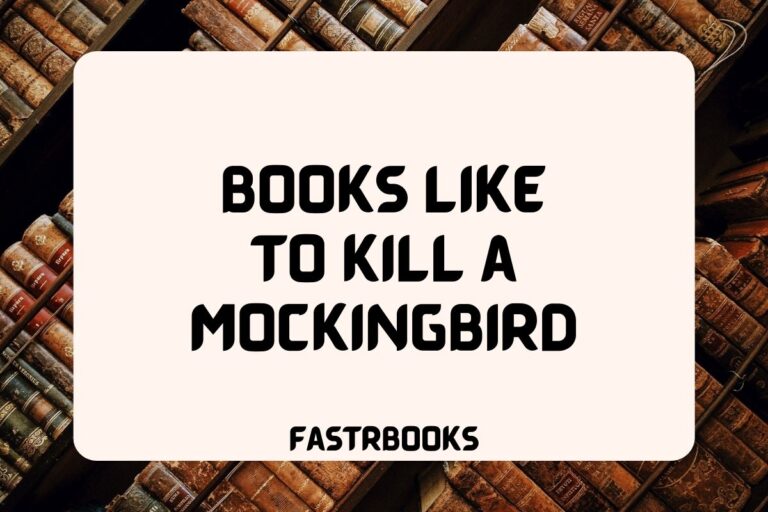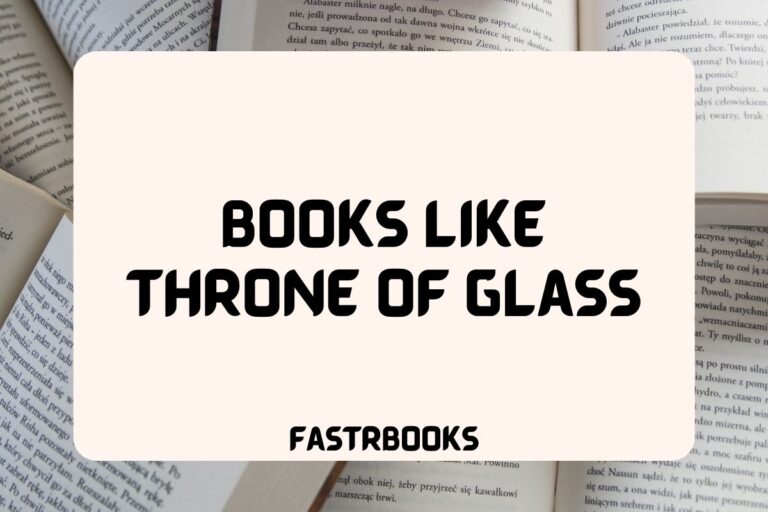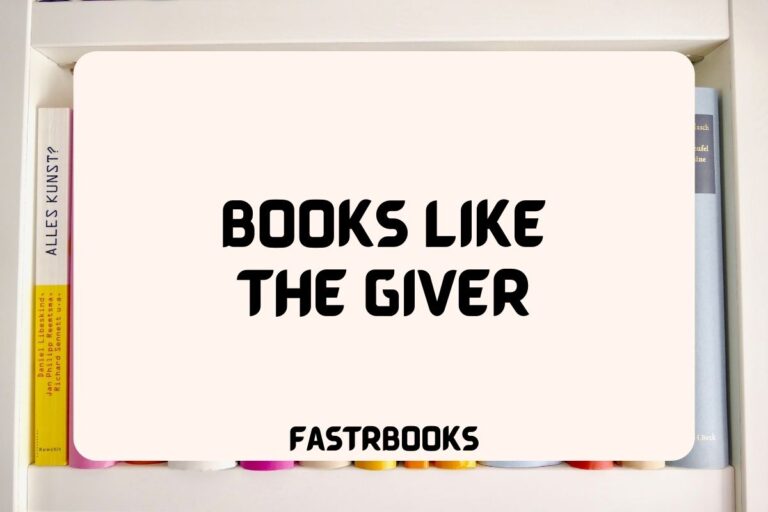14 Books Like Lord of the Flies
Have you ever wondered what would happen if a group of young people were stranded on a deserted island, left to fend for themselves without any adult supervision?
The possibilities are endless, and the outcome is often a gripping tale of survival, morality, and the complexities of human nature.
If you’re a fan of William Golding’s classic novel “Lord of the Flies,” which delves into these very themes, then you’re in for a treat.
In this blog post, we’ll explore a selection of books that share similar elements of adventure, conflict, and the exploration of the human psyche.
So, grab your metaphorical survival kit and prepare to embark on a literary journey that will both captivate and challenge your imagination.
Books Like Lord of the Flies
1. The Hunger Games by Suzanne Collins
“The Hunger Games” is a dystopian novel set in the post-apocalyptic nation of Panem, where the government in the Capitol forces each of its twelve districts to send a teenage boy and girl to compete in the Hunger Games, a televised fight to the death.
The story follows 16-year-old Katniss Everdeen, who volunteers to take her younger sister’s place in the games. The narrative explores themes of survival, government control, and societal inequality, as Katniss navigates the complexities of the Games and the political intrigue that surrounds them.
Major Similarities:
Like “Lord of the Flies,” “The Hunger Games” delves into themes of survival in an environment where societal norms have broken down. Both novels explore the dark aspects of human nature that emerge when individuals are placed in life-threatening situations and the societal structures that they are accustomed to are stripped away.
The struggle for power, the loss of innocence, and the moral dilemmas faced by the characters are central themes in both stories, providing a commentary on human nature and society.
2. The Maze Runner by James Dashner
“The Maze Runner” is the first book in a dystopian science fiction series that follows a group of teenagers, who wake up in a mysterious maze with no memory of the outside world, apart from their names.
The story centers on Thomas, who arrives in the maze and quickly realizes that their survival depends on working together to solve the maze’s secrets and confront the dangers within.
As they navigate the challenges, the group faces threats not only from the maze itself but also from the social dynamics that emerge within their group.
Major Similarities:
“The Maze Runner” shares with “Lord of the Flies” the theme of young people isolated from the adult world, forced to create their own society and confront the inherent challenges of leadership, trust, and survival.
Both novels depict the psychological and physical trials faced by the characters, the impact of group dynamics on individual behavior, and the transition from innocence to experience in extreme circumstances. The exploration of how societal structures form and dissolve under pressure is a central element in both stories.
3. Battle Royale by Koushun Takami
“Battle Royale” is a controversial Japanese novel set in an alternate timeline where Japan is a member nation of a totalitarian state. The government enacts a brutal law to control its youth: each year, a randomly selected class of ninth-grade students is taken to a deserted island, where they are forced to fight to the death until only one survivor remains.
The story focuses on Shuya Nanahara and his classmates as they are forced into this deadly game, exploring themes of friendship, betrayal, and the value of human life in the face of desperation.
Major Similarities:
Similar to “Lord of the Flies,” “Battle Royale” examines the breakdown of civilization and the emergence of violence among young people placed in a life-or-death situation.
Both novels probe the depths of human nature, questioning what happens when societal norms and laws are stripped away, and individuals are reverted to a state of nature.
The psychological depth of the characters, the exploration of moral ambiguity, and the critique of societal structures are key similarities between the two works.
4. The Road by Cormac McCarthy
“The Road” is a post-apocalyptic novel that tells the story of a father and his young son as they traverse a burned America, heading towards the coast with the hope of finding a warmer climate and a better life.
The world they walk through is bleak and ash-covered, with the remnants of civilization destroyed by an unspecified cataclysm.
The novel is a profound exploration of the bond between father and son, the struggle for survival, and the search for goodness in a world stripped of its humanity.
Major Similarities:
While “The Road” focuses on only two characters rather than a group, like “Lord of the Flies,” it deeply explores themes of survival in a world where the structures of society have collapsed. Both novels address the lengths to which individuals will go to survive and the moral decisions they must confront in desperate circumstances.
The desolate settings and the emphasis on the innate desire for community and connection under dire conditions are significant parallels.
5. A Clockwork Orange by Anthony Burgess
“A Clockwork Orange” is a dystopian novel set in a near-future society that is overrun by violence and governmental control. It follows the story of Alex, a delinquent teenager who revels in acts of ultra-violence, and his experiences with state authorities intent on reforming him.
The novel is known for its inventive language, a mix of Slavic and English, used to immerse the reader in Alex’s world. It explores themes of free will, the nature of evil, and the possibility of redemption.
Major Similarities:
“A Clockwork Orange” and “Lord of the Flies” both delve into the dark aspects of human nature and the capacity for violence. While “A Clockwork Orange” focuses on societal attempts to curb this violence through psychological manipulation, both novels raise questions about the inherent nature of humans and the impact of external pressures on individual morality.
The exploration of youth violence, the critique of societal and governmental structures, and the examination of free will tie these two narratives closely together.
6. Hatchet by Gary Paulsen
“Hatchet” is a young adult wilderness survival novel that tells the story of Brian Robeson, a thirteen-year-old boy who survives a plane crash in the Canadian wilderness.
Armed with only a hatchet, given to him by his mother, Brian must learn to survive on his own.
The novel explores Brian’s emotional and physical journey, detailing his struggles and growth as he learns to fend for himself in the wild, facing challenges such as finding food, building shelter, and dealing with the isolation.
Major Similarities:
Like “Lord of the Flies,” “Hatchet” explores themes of survival, isolation, and the transition from childhood to maturity under extreme conditions.
Both novels focus on young protagonists who are thrust into situations where they must fend for themselves without adult guidance, compelling them to confront their fears and adapt to their environments.
The element of human resilience and the capacity to learn and grow in the face of adversity are central to both stories.
7. The Wave by Todd Strasser
“The Wave” is based on a true experiment that took place at a California high school in 1969. The novel explores the story of a history teacher who, in an attempt to demonstrate the appeal of fascism and the ease with which individual freedom can be forfeited for community and power, starts a movement called “The Wave.”
The experiment spirals out of control as the movement grows, illustrating the dangers of groupthink, the allure of authoritarianism, and the importance of critical thinking and individuality.
Major Similarities:
Both “The Wave” and “Lord of the Flies” explore the themes of power, authority, and the human propensity to succumb to group dynamics and leadership, for better or worse. Each story serves as a cautionary tale about the potential for societal constructs to become oppressive and the importance of maintaining individual morals and ethics in the face of collective pressure.
The psychological manipulation and the breakdown of individual judgment in favor of group identity are key elements that resonate between the two narratives.
8. The Giver by Lois Lowry
“The Giver” is a dystopian novel set in a seemingly utopian society without pain, war, or suffering, where every aspect of life is controlled by the government.
The story follows a twelve-year-old boy named Jonas, who is selected to inherit the position of Receiver of Memory, the person who stores all the past memories of the time before sameness.
As Jonas receives these memories, he begins to question the society’s principles and confronts the reality of the choices that have been made to achieve this uniformity.
Major Similarities:
“The Giver” and “Lord of the Flies” both examine the themes of societal structure, the loss of innocence, and the questioning of authority.
While “The Giver” explores these themes in a controlled, dystopian society and “Lord of the Flies” in a state of nature, both novels highlight the impact of societal constraints on individual freedom and the inherent complexities of human nature.
The protagonists in both stories undergo significant personal growth as they confront these realities.
9. Animal Farm by George Orwell
“Animal Farm” is an allegorical novella that depicts the story of a group of farm animals who revolt against their human farmer, hoping to create a society where the animals can be equal, free, and happy. However, the rebellion’s initial success leads to a new tyranny among the animals themselves.
The novel is a critique of totalitarian regimes and explores themes of power, corruption, and betrayal, as the ideals of the revolution give way to the reality of new forms of oppression.
Major Similarities:
Both “Animal Farm” and “Lord of the Flies” offer a critical examination of societal structures and the corrupting influence of power. Each story begins with an attempt to escape oppressive conditions, only to find that the very elements they sought to evade can emerge from within.
The novels delve into the darker aspects of leadership and governance, illustrating how noble intentions can be undermined by selfishness, fear, and the desire for control.
10. Heart of Darkness by Joseph Conrad
“Heart of Darkness” is a novella that follows the journey of Marlow, a riverboat captain, as he travels into the African interior in search of Kurtz, an ivory trader who has gone missing. The story is a complex exploration of imperialism, colonialism, and the inherent darkness within the human soul.
As Marlow ventures deeper into the jungle, he confronts not only the horrors of European colonial exploitation but also the primal fears and moral dilemmas that lie within himself and humanity as a whole.
Major Similarities:
Like “Lord of the Flies,” “Heart of Darkness” explores the themes of civilization versus savagery and the thin veneer that separates cultured society from the primal instincts of humanity. Both novels are concerned with the darkness that resides in the human heart and the conditions that allow it to surface.
The journey into the wilderness serves as a metaphor in both stories for the exploration of the human psyche and the capacity for evil that exists within all individuals.
11. The Lord of the Rings by J.R.R. Tolkien
“The Lord of the Rings” is a high-fantasy trilogy that tells the epic story of Middle-earth’s battle against the dark lord Sauron, who seeks to conquer the world through the power of the One Ring.
The narrative follows a diverse group of heroes, including hobbits, elves, dwarves, and men, as they embark on a perilous journey to destroy the Ring. This saga explores themes of bravery, friendship, and the struggle between good and evil, as well as the heavy burden of carrying a power that can corrupt absolutely.
Major Similarities:
While “The Lord of the Rings” and “Lord of the Flies” belong to different genres, they share significant themes such as the inherent struggle between good and evil, the corrupting influence of power, and the importance of unity and cooperation to overcome adversity.
Both stories delve into the complexity of human (or humanoid) nature and the capacity for both nobility and malevolence, challenging characters to make moral choices in the face of dire circumstances.
12. Watership Down by Richard Adams
“Watership Down” is a novel that follows a group of rabbits as they escape the destruction of their warren and seek a new home, encountering various dangers and challenges along the way.
This adventure story, while featuring animals as characters, delves into themes of leadership, society, and survival, exploring the complexities of freedom, the natural world, and the bonds that form within communities facing adversity.
Major Similarities:
Similar to “Lord of the Flies,” “Watership Down” explores the formation of societies and the dynamics of leadership and governance within a group removed from their normal environment. Both novels feature characters who are forced to navigate new social structures and confront internal and external threats to their survival.
The themes of resilience, the impact of environment on societal development, and the moral questions that arise in the face of survival are central to both stories.
13. The Beach by Alex Garland
“The Beach” is a novel that follows Richard, a young backpacker who finds himself in possession of a map that supposedly leads to a legendary, idyllic beach paradise in Thailand.
As Richard and his newfound friends make their way to the beach, they discover a secretive community of travelers living there.
However, the utopia they find soon reveals a darker side, as isolation and paradise become a prison of their own making, leading to psychological and physical breakdowns.
Major Similarities:
“The Beach” shares with “Lord of the Flies” the exploration of an isolated paradise that becomes a stage for human psychology and societal breakdowns to unfold.
Both narratives delve into the idea that utopian dreams can quickly devolve into dystopian realities when faced with the complexities of human nature, leadership, and community living. The degradation of societal norms and the surfacing of primal behaviors in secluded environments are key themes in both books.
14. Never Let Me Go by Kazuo Ishiguro
“Never Let Me Go” is a dystopian science fiction novel that unfolds in a parallel history where humans have extended their lifespan through medical science.
The story is told through the perspective of Kathy, a carer who reminisces about her childhood at Hailsham, a seemingly idyllic boarding school, and the deep relationships she formed there with her friends Tommy and Ruth.
As the narrative progresses, the disturbing reality behind their existence and the purpose of their upbringing is revealed, exploring themes of humanity, memory, and loss.
Major Similarities:
While “Never Let Me Go” and “Lord of the Flies” vastly differ in setting and premise, both novels deeply examine the loss of innocence and the harsh confrontations with reality faced by young individuals.
Each story invites readers to reflect on the nature of society and the roles individuals are thrust into, often against their will. The exploration of complex emotional landscapes and the critical examination of the constructs that govern our lives are central themes in both works.






